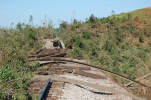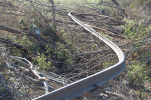Navigation
Install the app
How to install the app on iOS
Follow along with the video below to see how to install our site as a web app on your home screen.
Note: This feature may not be available in some browsers.
More options
-
Welcome to TalkWeather! We see you lurking around TalkWeather! Take the extra step and join us today to view attachments, see less ads and maybe even join the discussion. CLICK TO JOIN TALKWEATHER
You are using an out of date browser. It may not display this or other websites correctly.
You should upgrade or use an alternative browser.
You should upgrade or use an alternative browser.
DanLarsen34
Member
A thought I’ve had with all of this discussion of contextual damage: when it comes to examples of intense debarking, ground scouring, etc…I would think it would be possible to document each instance of this and accumulate that data to see how often these things have happened and what the intensity of the tornadoes were based on rating.
For example, if we have extensive documentation of modern F5 and EF5s, it should be possible to log the frequency in which certain extreme contextual indicators have happened. Doing this would give us a statistical estimate of how often these things happen with high-end tornadoes which could then be used to further corroborate that those events only occur in extremely violent tornadoes. You could even throw in EF-4s since several higher end ones have been extensively debated as possible or probable EF-5s based on contextual indicators.
I know this would get harder to do with older tornadoes, but I would imagine that someone could assemble a study on this that goes back to at least the 1999 Moore tornado?
For example, if we have extensive documentation of modern F5 and EF5s, it should be possible to log the frequency in which certain extreme contextual indicators have happened. Doing this would give us a statistical estimate of how often these things happen with high-end tornadoes which could then be used to further corroborate that those events only occur in extremely violent tornadoes. You could even throw in EF-4s since several higher end ones have been extensively debated as possible or probable EF-5s based on contextual indicators.
I know this would get harder to do with older tornadoes, but I would imagine that someone could assemble a study on this that goes back to at least the 1999 Moore tornado?
DanLarsen34
Member
Just to further expand on this idea, you could add in radar data (Vrot and depth of the CC drop) for more recent tornadoes that produced extreme contextual damage, but may not have impacted any substantial structures during their lifespans.A thought I’ve had with all of this discussion of contextual damage: when it comes to examples of intense debarking, ground scouring, etc…I would think it would be possible to document each instance of this and accumulate that data to see how often these things have happened and what the intensity of the tornadoes were based on rating.
For example, if we have extensive documentation of modern F5 and EF5s, it should be possible to log the frequency in which certain extreme contextual indicators have happened. Doing this would give us a statistical estimate of how often these things happen with high-end tornadoes which could then be used to further corroborate that those events only occur in extremely violent tornadoes. You could even throw in EF-4s since several higher end ones have been extensively debated as possible or probable EF-5s based on contextual indicators.
I know this would get harder to do with older tornadoes, but I would imagine that someone could assemble a study on this that goes back to at least the 1999 Moore tornado?
You’d also need to distinguish, in the case of debarking, between instances where that likely occurred by wind versus by debris.
Aaron Rider
Member
In that era, New Richmond, Sherman, and Pomeroy stand out as ludicrously violent.I'm surprised with the intensity ratings that 1896 Sherman, TX is not being mentioned.
At what point do we stop moving the goal posts for a tornado to get an EF5? Do non-standard DIs need to be an oil rig each time?I think it was an EF5 strength tornado, what it did and the truth of what is needed to do it, a lot more confusing. Do I think it will get downgraded, no. Do I think unless other examples of this type of damage are looked into with the same amount of detail, past or future, that this is a strange rating, yea kinda.
Kinda on the fence, it's just such a weird time to implement this stuff but with such an extreme example I kinda get it, but there are real things to be talked about that is "wrong" with the calculations done.
In terms of non-standard EF5 DIs, I like the idea but the only other ones we have are Philadelphia (not an EF5 imo) and Piedmont (most clear EF5 you can get really)
I always figured the tornado that broke the drought would be nitpicked. However, this one had a legitimate panel of experts and engineers, all who agreed this tornado was an EF5. This wasn’t an instance of an office going rogue and haphazardly handing out a rating. I just don’t think there’s a scenario where these questions and issues weren’t discussed or thought of while the review was ongoing.
Last edited:
Another example would be Tuscaloosa where 600 feet of track were lost, with some sections bent into large U shapes with one end was touching the other.From what I've seen/heard, Chapman seems to be the most outstanding example of the very rare "railroad track damage", all the other examples of torn up or bent tracks, which I know of at least 3 others including Tri State, were insanely debris loaded in the areas the tracks were bent or destroyed, at least from what we know Chapman didn't hit the tracks with anything except wind and ballast, maybe a car to be real tho because it was an insane tornado, and it still shoved 300ft of it off the center of the ballast it was laying on.


The difference is though that tri-state is the only one to rip them upright. Not just deform them. And it did so in multiple locations.From what I've seen/heard, Chapman seems to be the most outstanding example of the very rare "railroad track damage", all the other examples of torn up or bent tracks, which I know of at least 3 others including Tri State, were insanely debris loaded in the areas the tracks were bent or destroyed, at least from what we know Chapman didn't hit the tracks with anything except wind and ballast, maybe a car to be real tho because it was an insane tornado, and it still shoved 300ft of it off the center of the ballast it was laying on.
